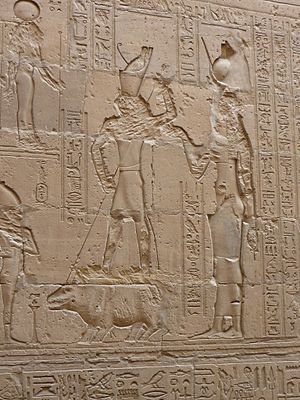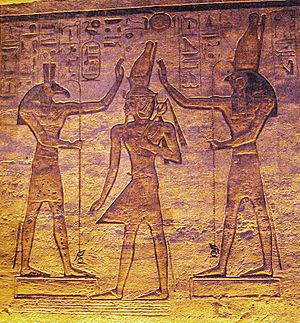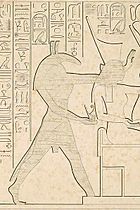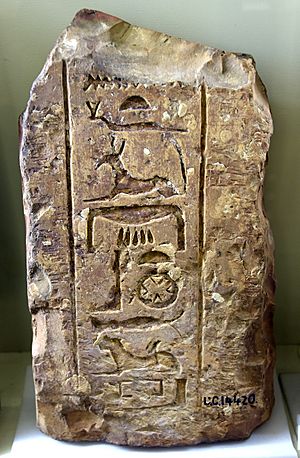Set (deity) facts for kids
Quick facts for kids Set |
|
|---|---|
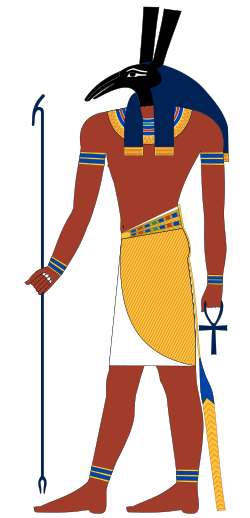 |
|
| Major cult center | Ombos, Avaris, Sepermeru |
| Symbol | Was-sceptre, Set animal |
| Personal information | |
| Consort | Nephthys, Neith, Anat, and Astarte |
| Offspring | Anubis, Wepwawet, Sobek and Maga |
| Parents | Geb, Nut |
| Siblings | Osiris, Isis, Nephthys, Horus the Elder |
| Equivalents | |
| Greek equivalent | Typhon |
Set is a god of deserts, storms, disorder, violence, and foreigners in ancient Egyptian religion.
He was lord of the Red Land (desert), where he was the balance to Horus' role as lord of the Black Land (fertile land).
In the Osiris myth, the most important Egyptian myth, Set is portrayed as the usurper who murdered his own brother, Osiris. Osiris's sister-wife, Isis, reassembled his body and resurrected her dead husband with the help of the goddess Nephthys. Then she gave birth to their son and heir, Horus. Horus sought revenge upon Set and many of the ancient Egyptian myths describe their conflicts.
Seth is related to the west of Nile which is the Sahara.
Contents
Family
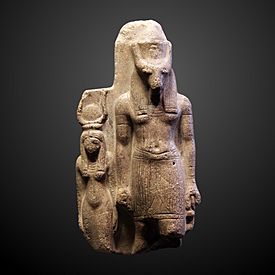
Set is the son of Geb, the Earth, and Nut, the Sky; his siblings are Osiris, Isis, and Nephthys. He married Nephthys and fathered Anubis and Wepwawet. In some accounts, he had relationships with the foreign goddesses Anat and Astarte. From these relationships is said to be born a crocodile deity called Maga.
Set animal
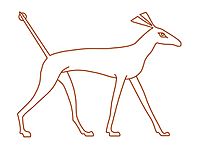
In art, Set is usually depicted as a creature known as the Set animal, a beast not identified with any known animal, although it could be seen as a resembling an aardvark, an African wild dog, a donkey, a hyena, a jackal, a pig, an antelope, a giraffe, an okapi, a saluki, or a fennec fox.
The animal has a downward curving snout; long ears with squared-off ends; a thin, forked tail with sprouted fur tufts in an inverted arrow shape; and a slender canine body. Sometimes, Set is depicted as a human with the distinctive head. Some early Egyptologists believed that it was a representation of the giraffe, owing to the large flat-topped "horns" which correspond to a giraffe's ossicones. The Egyptians themselves, however, used distinct depictions for the giraffe and the Set animal. During the Late Period, Set is usually depicted as a donkey or as a man with the head of a donkey, and in the Book of the Faiyum, Set is depicted with a flamingo head.
The earliest representations of what might be the Set animal comes from a tomb dating to the Amratian culture ("Naqada I") of prehistoric Egypt (3790–3500 BCE), although this identification is uncertain. If these are ruled out, then the earliest Set animal appears on a ceremonial macehead of Scorpion II, a ruler of the Naqada III phase. The head and the forked tail of the Set animal are clearly present on the mace.
Conflict of Horus and Set
An important element of Set's mythology was his conflict with his brother or nephew, Horus, for the throne of Egypt. The contest between them is often violent but is also described as a legal judgment before the Ennead, a group of Egyptian deities, to decide who should inherit the kingship. The judge in this trial may be Geb, who, as the father of Osiris and Set, held the throne before they did, or it may be the creator gods Ra or Atum, the originators of kingship.
The rivalry of Horus and Set is portrayed in two contrasting ways. Both perspectives appear as early as the Pyramid Texts, the earliest source of the myth. In some spells from these texts, Horus is the son of Osiris and nephew of Set, and the murder of Osiris is the major reason for the conflict. The other tradition depicts Horus and Set as brothers. This inconsistency is present in many of the subsequent sources, where the two gods may be called brothers or uncle and nephew at different points in the same text.
The divine struggle involves many episodes. The two gods appealed to various other deities to arbitrate the dispute and competed in different types of contests, such as racing in boats or fighting each other in the form of hippopotami, to determine a victor. In this account, Horus repeatedly defeats Set and is supported by most of the other deities. Yet the dispute drags on for eighty years, largely because the judge, the creator god, favors Set. In late ritual texts, the conflict is characterized as a great battle involving the two deities' assembled followers.
In one of the episodes Set damages or tears out one, or occasionally both, of Horus's eyes. Sometimes the eye is torn into pieces. The removal of Horus's eye is even more important, for this stolen eye of Horus represents a wide variety of concepts in Egyptian religion. One of Horus's major roles is as a sky deity, and for this reason his right eye was said to be the sun and his left eye the moon. The theft or destruction of the eye of Horus is therefore equated with the darkening of the moon in the course of its cycle of phases, or during eclipses. Horus may take back his lost Eye, or other deities, including Isis, Thoth, and Hathor, may retrieve or heal it for him.
The restoration of the eye of Horus represents the return of the moon to full brightness and the return of the kingship to Horus.
Protector of Ra
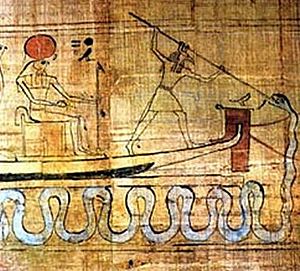
Set was depicted standing on the prow of Ra's barge defeating the dark serpent Apep. In some Late Period representations, such as in the Persian Period Temple of Hibis at Khargah, Set was represented in this role with a falcon's head, taking on the guise of Horus. In the Amduat, Set is described as having a key role in overcoming Apep.
Set in the Second Intermediate, Ramesside and later periods
During the Second Intermediate Period (1650–1550 BCE), a group of Near Eastern peoples, known as the Hyksos (literally, "rulers of foreign lands") gained control of Lower Egypt, and ruled the Nile Delta, from Avaris. They chose Set, originally Upper Egypt's chief god, the god of foreigners and the god they found most similar to their own chief god, Hadad, as their patron. Set then became worshiped as the chief god once again. The Hyksos King Apophis is recorded as worshiping Set exclusively.
When Ahmose I overthrew the Hyksos and expelled them, in c. 1522 BCE, Egyptians' attitudes towards Asiatic foreigners became xenophobic, and royal propaganda discredited the period of Hyksos rule. The Set cult at Avaris flourished, nevertheless, and the Egyptian garrison of Ahmose stationed there became part of the priesthood of Set.
The founder of the Nineteenth Dynasty, Ramesses I came from a military family from Avaris with strong ties to the priesthood of Set. In addition, one of the garrisons of Ramesses II held Set as its patron deity, and Ramesses II erected the so-called "Year 400 Stela" at Pi-Ramesses, commemorating the 400th anniversary of the Set cult in the Nile delta.
Set also became associated with foreign gods during the New Kingdom. Set was identified by the Egyptians with the Hittite deity Teshub, who, like Set, was a storm god, and the Canaanite deity Baal, being worshipped together as "Seth-Baal".
Additionally, Set is depicted in part of the Greek Magical Papyri, a body of texts forming a grimoire used in Greco-Roman magic during the fourth century CE.
The demonization of Set
The demonization of Set took place after Egypt's conquest by several foreign nations in the Third Intermediate and Late Periods. Set, who had traditionally been the god of foreigners, thus also became associated with foreign oppressors, including the Kushite and Persian empires. It was during this time that Set was particularly vilified, and his defeat by Horus widely celebrated. Set's negative aspects were emphasized during this period.
Set temples
Set was worshipped at the temples of Ombos (Nubt near Naqada) and Ombos (Nubt near Kom Ombo), at Oxyrhynchus in Upper Egypt, and also in part of the Fayyum area.
More specifically, Set was worshipped in the relatively large metropolitan (yet provincial) locale of Sepermeru, especially during the Ramesside Period. There, Seth was honored with an important temple called the "House of Seth, Lord of Sepermeru". One of the epithets of this town was "gateway to the desert", which fits well with Set's role as a deity of the frontier regions of ancient Egypt. At Sepermeru, Set's temple enclosure included a small secondary shrine called "The House of Seth, Powerful-Is-His-Mighty-Arm", and Ramesses II himself built (or modified) a second land-owning temple for Nephthys, called "The House of Nephthys of Ramesses-Meriamun".
Another moderately sized temple of Seth is noted for the nearby town of Pi-Wayna.
Seth's cult persisted even into the latter days of ancient Egyptian religion, in outlying but important places like Kharga, Dakhlah, Deir el-Hagar, Mut, and Kellis. In these places, Seth was considered "Lord of the Oasis / Town" and Nephthys was likewise venerated as "Mistress of the Oasis" at Seth's side, in his temples.
Interesting facts about Set
- In Ancient Greek, the god's name is given as Sēth (Σήθ).
- In ancient Egyptian astronomy, Set was commonly associated with the planet Mercury.
- Seth is sometimes associated with a lesser deity, Ha, god of the desert, which is a deity depicted as a man with a desert determinative on his head.
- Several of the Egyptian kings were named after the god, most notably Seti I (literally, "man of Set") and Setnakht (literally, "Set is strong").
See also
 In Spanish: Seth para niños
In Spanish: Seth para niños



